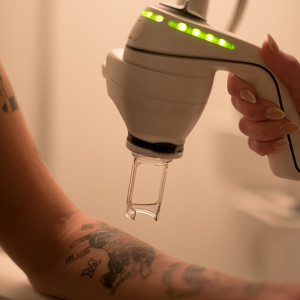CHAPTER 11
By the turn of the millennium, tattooing had never been more popular — and neither had laser tattoo removal.
It’s pretty easy to spot a 90s tattoo. The designs from this decade are some of the most recognisable of all time — although most not exactly in a good way. Barbed wire armbands, Chinese letters, Celtic symbols, teeny-tiny butterflies, stars and hearts; they all had their moments in the nineties. This is because, more than any other decade previously, 90s tattoo trends were driven by celebrities - and a few key celebs at that. This explains the popularity of a few specific designs - which millions of people went crazy for - which are now a tad cliché. The most popular tattoos of the 90s were actually an evolution of the 80s’ New School and tribal designs — just updated to fit 90s pop culture and an increasingly female fan base. (Picture a homage to Mrs. Doubtfire, the X-Files, Spice Girls, Beavis and Butthead, the Fresh Prince of Bel-Air, Buffy the Vampire Slayer, Clueless and Seinfeld tattooed on your body in full-colour. Oh yes.) But why the sudden surge of interest in body art from women? For that, we can thank third-wave feminism. After massive gains in the 70s, feminism had faltered by the late 80s and it wasn’t cool at all in very early 1990s. “Few pop cultural figures embraced the term “feminist.” The underground punk movement known as “Riot Grrrl” scared anyone outside of it (which was part of its point), while Alanis Morissette’s breakthrough single “You Oughta Know” scared everyone else even more. Then, in the middle of the decade, the Spice Girls took all of that fear and made feminism - popularised as Girl Power - "fun”.
Publish Date in article
Gwen Stefani’s razor-thin eyebrows were a 90s must-have, but when the trend passed, permanent makeup became a good solution for women wanting to fill out their brows again.
Suddenly tattoos became symbols of female strength and independence — even though, out of the Spice Girls, only Mel C had body art. The result? “By 1996, more than half of those seeking tattoos are women. Tattoos began to lean toward more feminine designs, with butterflies, hearts and stars merging with tribal bands,” according to Cloak and Dagger. With more and more women getting tattooed than ever before, it’s not surprising that this is when permanent makeup first took off – although this was also driven by the decade’s brow trends. “When permanent makeup first surfaced in the 90’s, it developed out of necessity. People who were victims of the 90’s thin eyebrow trend were desperate for a solution. So much so that they were willing to have a flat, tattooed stamp-like eyebrow just to give them some kind of frame to their face,” according to makeup blog Tina Davies.

Of course, the 90s tattoo scene wasn’t all about women. “Sports stars, especially those in basketball, started getting extensively inked and brought even greater visibility and acceptance to the art form, even if some of the specific tattooed characters, such as ‘bad boy’ Dennis Rodman, continued to perpetuate an outlaw, anti-establishment spirit,” writes Anna Felicity Friedman, author of The World Atlas of Tattoos. According to Rolling Stone magazine, “Dennis Rodman’s unique look - including his tattoos - made him a pop culture icon in the 1990s.”
Publish Date in article
The 90s is also considered “the golden age of hip hop.” Tupac’s “Thug Life” tattoo is the most famous - and controversial - in hip hop history. It “created a moral panic back in the early ’90s when media outlets denounced the rap prodigy for inciting violence. Conversely to what was believed, THUG LIFE was a powerful statement against systemic racism. Then there was the emergence of grunge. “The 90s would not be the 90s without grunge, and grunge would not be grunge without Nirvana,” according to the blog Tattoo. Kurt Cobain himself only had one small tattoo (the letter ‘K’) but his death in 1994 inspired die-hard Nirvana fans to get tattooed in his honour.
Publish Date in article
“By the 1990s, tattoos were commonplace, visible on rock stars, athletes, and Playboy Bunnies.” writes Timeline.
And who can forget Pamela Anderson’s barbed wire armband, which became one of the biggest tattoo trends of the decade? The tribal design and placement on the upper arm were classic 90s. Meanwhile Mel C (aka “Sporty Spice”) rocked Chinese letters and the tribal armband. Thanks to the Spice Girls, tattoos became symbols of female empowerment - better known as “girl power” - and they exploded in popularity around the world.
Publish Date in article
Elsewhere in the pop world, Justin Timberlake’s Celtic cross was bang-on trend for the 90s. He comes from a Christian background so it wasn’t just a fashion statement — it’s said to “openly symbolise his faith in Jesus Christ.” Mariah Carey, meanwhile, debuted her teeny-tiny, ultra-feminine butterfly tattoo and millions of women copied her. “Feminine tattoos - like butterflies, hearts, stars, dolphins, suns - enjoyed a boom during the 90s,” according to Inkbox. More generally, New School tattoos in the 90s were a celebration of pop culture at the time: Mrs Doubtfire competed for skin with Seinfield, Friends, the X-Files and the Fresh Prince of Bel-Air — to name a few key trends. And while tattooing had never been more popular, laser tattoo removal was also becoming more common. This was thanks to a new type of laser entering the market which could remove tattoos with less pain and less scarring. Celebs like Cher famously started removing her 1970s tattoos in the 1990s.









